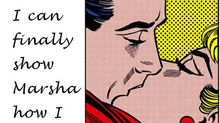Why Teach Vis-Ed?
- lastcathar
- Dec 23, 2014
- 6 min read
Advertisers know that images can be a powerful tool for planting ideas. Back in '67, for example, this image gave me the idea that I needed to buy a motorcycle.
Advertisers are heavy into creating images, and it pays. Images can shape the market and move merchandise. If carefully crafted images can increase sales, it follows that they can also be used to increase learning. The right image can bring an idea to life more effectively than a lot of talking, reading, or explaining.
For an idea of how images can be made to speak, check out this compilation video of spoof ads from Adbusters.org. In response to what they perceived as advertising's excessive and damaging influence on our culture, Adbusters uses the tools of the trade to send their own anti-advertising message. This is visual rhetoric at its finest.
Each of these images makes a statement, makes you stop and think. Any one of these is easily worth a class discussion, a freewrite, or an essay. Shoot a well-chosen image up on the screen and let your students think about it, talk about it, find meaning in it. The process of finding meaning is weightlifting for neurons.
The next (very short) video is the real thing, real advertising images. Contrast these with the message and method of Adbusters. Advertising is a wondrous land of influence and inspiration, but too often its carefully-crafted images are designed specifically to sidestep conscious consideration, to NOT make you stop or think. If thinking sheds light on a subject, advertising is a language where the sun don't shine.
These examples show why we, as teachers, should make visual images central elements in our lessons. It is our job to prepare students to be the leaders of tomorrow. The ability to create and interpret images, the mental agility it takes to see through appearances, and the communication skill required to share your vision for the future by literally making others see it with their own eyes, these are the skills that have, for better of worse, shaped the present. The more people who can actively take part in this process, the more representative and diverse our future can be.
Only 23% of Americans read print newspapers, while 99% of homes have a television (66% of homes have three) and the average American watches five hours of television.
Whether you see this as an epidemic or a blessing, it is a fact. This is the reality of modern communication. Many see it as a threat to representative government, as sources of information become more and more centralized and inaccessible to any but the most powerful (and well-heeled) voices. These voices are, in reality, predominantly visual...for all of the above reasons. Images can guide ideas without passing through that pesky stop-and-think phase. We should be empowering students to participate in this mode of cummunication, not remain mere consumers of what is created by the well-financed few.
But how does a teacher work images into leassons? In fact they are perfect for the student-centered, active learning classroom. The fact images speak to everybody without the need for a translator means you don't have to "teach" them, just show them.
A photograph of a school bus in India. Show this to the class and then say something like, "Get a partner. What I'd like you and your partner to do is just think about this picture. What does this picture say about the culture, the value of education, the economy in this place?" Or just say, "What ideas come to mind when you see this picture."
This seems like a pretty wide-open assignment, but not really. A lot of unproductive lines of thought have been eliminated by mentioning the productive lines first, nudging the students in a good direction with their discussions...but without telling them what to think.
Because it leaves the meaning of the image entirely up to the students, this represents open-ended, student-centered, active instruction. As they do this little task they will touch upon many of the foundational features of good writing. In the course of a semester, after doing many active learning tasks like this, your students will experience those features of good writing many times, in many ways. This adds up to real knowing.

Dual-coding is a learning theory suggesting that learning is enhanced, deepened and reinforced if information is "coded" in multiple ways. Paivio's experiments in 1971 combined verbal with visual... many of the same ideas are inherent in Richard Mayer's conception of "multimedia learning" or "eLearning." Build up layers and facets of learning by giving students many ways of getting it. Mayer's "modality principle" suggests students see and hear together, but not read...sight and sound are our natural way of intaking information from our environment.
That picture of a school bus in India is, thus, exactly opposite of the weaknesses that have been demonstrated in textbook-based education. Rather than strictly reading about some topic, students are seeing it, talking about it, hearing each others' thoughts, and most importantly, they are engaging with the material creatively, making something out of it...making it their own. They are directing their own learning. By showing them a picture and saying thiry-odd words, you have become cutting edge.
A hard act to follow. Here is one way to build on the first act, and make it expand. Your next move is to show the class this picture...
...and say, "This was taken about half-a-mile from the "school bus" picture. Now, here's your challenge. Taken together, what do these two pictures tell us? What do we know about the people, the country, the culture, the value of education, the economy...what can you and your partner say about this place, based on these two pictures?"
This then becomes a much larger task. Not larger in terms of word count or required product...adding requirements would only choke off engagement with the material. You want students to think about the picture, not think about you or your requirements. The act of making their own discoveries and putting those into their own words is the heavy lifting you are after. The product they finally come up with is very secondary. By leaving the result, the "product" entirely immaterial and personal, you allow students the freedom to really think, and thinking is weightlifting for neurons. A topic like this one is wide open: it can go as far as a student wants to take it.
This two-pic analysis is larger because they will have to synthesize the two very different images, and find meaning in the combination. On top of that, since they are working in pairs they will have to negotiate their "internal" dialogs and make them external and spoken, and then synthesize these. Now, what they are working with is a synthesis of abstract ideas that they themselves have generated based on the two images. That is some serious mental weightlifting, and to me that is ideal. Any topic so bland, so flat, so limited as to be entirely covered in an hour, is not a brain-stretcher, it is a meaningless exercise. Let students face the big issues, let them come up against huge topics. Trust them to learn. That is the only way those big issues will ever be solved.
What I've described is not a complex series of steps, not a convoluted and confusing set of instructions. But certainly for some students this will be pretty big, pretty hard. How does a teacher strike a balance, what objective expectations can most of the students meet when the task is difficult?
By making the instructions as simple as possible, they can be interpreted flexibly, individually. Remember, it is not the product but the process that reflects the learning that's taking place. Just doing the mental exercise IS the assignment, is the workout we want to see. The product itself is not the issue. Now, if some student simply does not engage with the material, does not try, then when the class stands two-by-two to describe what they came up with, that non-participating student will stick out and end up embarassed. That too can bring learning, naturally and socially, with no need for a pronouncement or judgment from the teacher...the learning will happen. If two teams come up with opposite ideas, the question is not about who is right; it is one of explaining how they arrived at their conclusion, providing explanation or evidence supporting their reasoning. If both can do that, then both did a great job of thinking about the material, and both have learned, have gained skill at analysis, at argumentation, at critical thinking.
Finding meaning is, as I said, neuron-building, brain building, but you, the teacher, will have done more than just teach a lesson. You have shown that you trust your students to be pretty smart. You have shown that you trust them to have the ability to think about things. This may sound like nothing, but it can build a safe, open learning environment, a non-adversarial relationship between students and yourself, a classroom where the work is not connected to a threat. You will build a classroom where the students are a team and you are the person who keeps them supplied with basketballs, the person who is confident they will hit the hoop.





























Comments